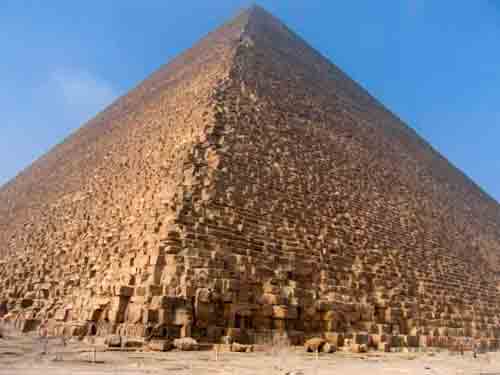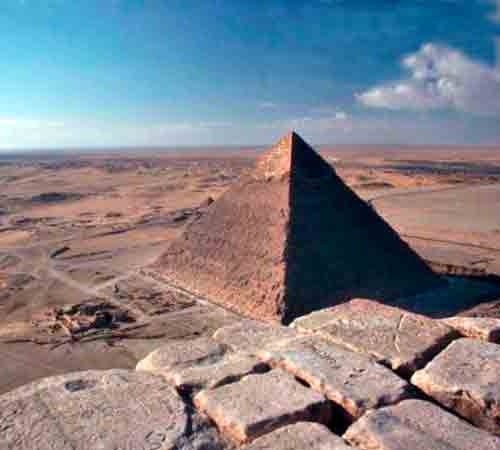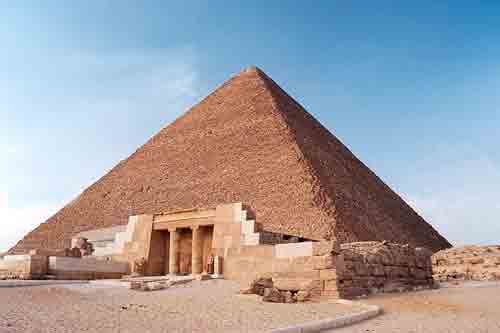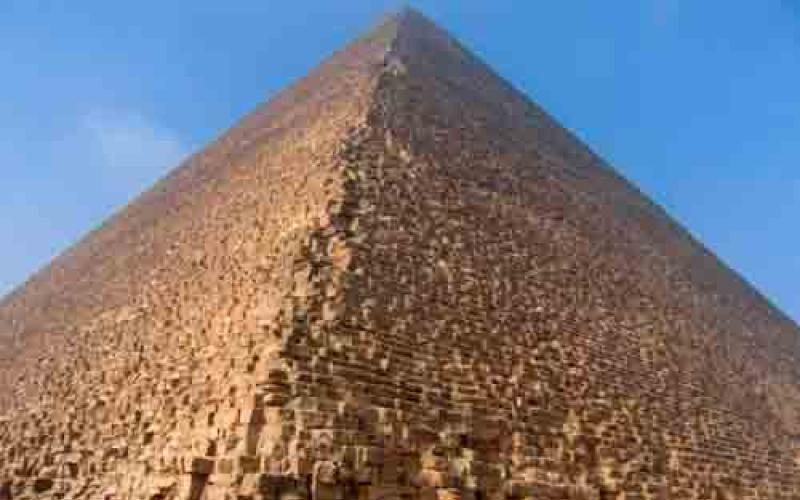For more than one century, they have been exciting the minds of researchers and all those who are interested. Especially many mysteries are hidden by the three pyramids, which are located in Giza, not far from the present Cairo.
On the rocky plateau of the desert, they stand, casting clear shadows on the sand - three huge geometric bodies, perfectly regular tetrahedral pyramids, which are considered to be the tombs of the pharaohs Cheops, Khafre and Mykerin. The largest of them - the pyramid of Cheops (Khufu) - is called the Great Pyramid.

In 1864, astronomer Charles Piazzi Smith suggested that the pyramid of Cheops was built to embody in this form a number of aspects of ancient, highly advanced knowledge. He had followers trying to unravel the mystery of this Egyptian pyramid.

There was an assumption about the uniqueness of the Cheops pyramid in a number of other monuments of Ancient Egypt. Its supporters argued that it was built by the will of a higher mind by aliens from worlds with a more perfect civilization than on earth. It was assumed that ancient prophecies were encrypted in the design of the pyramid, its parameters, which later formed the basis of the Old Testament, predetermined the future history of Christianity and predict the second coming of Christ.

When measuring the Cheops pyramid itself, it turned out that the perimeter of the Giza pyramid, divided by double the height, gives the exact number "Pi", with an accuracy of one hundred thousandth. Interestingly, the sacred measure of the length of Egypt, i.e. the pyramidal inch (coincidentally equal to modern English) is one billionth of the Earth's orbit in 24 hours. The sum of the two diagonals of the Egyptian pyramid, expressed in inches, gives the number of years during which the north pole of our earth makes one complete revolution. The volume of the pyramid multiplied by the specific gravity of the stone from which it is made gives the theoretical weight of the globe, and so on.
There are now many theories about how these Egyptian pyramids were built. According to some authors, the pyramid of Cheops was built by aliens; according to others, the blocks were transferred to their places with the help of a magic crystal.
In the 1980s, Robert Bauval, a Belgian civil engineer, drew attention to the stellar counterpart of the Giza pyramids. The pattern of the relative position of the three stars in the constellation of Orion, forming a kind of belt at the waist of a human figure, exactly repeats the layout of the three largest pyramids on the Giza plateau. The Great Pyramid and the similarly sized Pyramid of Khafre take the place of the two brightest stars in Orion's belt, Al-Nitak and Al-Nilam, while the smaller pyramid of Menkaur is offset from the axis of the two neighbors, just like the third and smallest star of the belt, Mintaka.
Such an obvious analogy posed a direct challenge to orthodox archeology, which claimed that the religion of the Egyptians was based on the worship of the sun, and not the starry sky. Be that as it may, the existence of the phenomenon cannot be denied.
Graham Hancock, author of Footprints of the Gods, who is working on an alternative interpretation of the history of the ancient world, believes that Bauval's observation allows the pyramids to be dated by no means 2500 BC. e., and approximately 10,450 BC. e., when the outlines of Orion's belt corresponded exactly to the location of the pyramids. Pyramids are one of the many evidences in favor of the existence of some advanced civilization in that ancient era. Meanwhile, the indicated era fits into the time frame of the existence of the legendary Atlantis, although no one undertakes to assert that the civilization that built the early pyramids was indeed the civilization of the Atlanteans.
Interesting data was given by the American scientist John Anthony West, who drew attention to the fact that two objects - the Sphinx and the Temple of the Valley, located at a distance of several hundred meters from each other, have distinct traces of strong water erosion. The giant figure of the Sphinx is located in a hollow of a steep slope, from the rock of which it was carved. Such a hollow fills with sand very quickly, and the likelihood that in arid desert conditions the sand was washed out by rain torrents is extremely small. But it was not always so. The Sahara region began to turn into a sandy desert only at the end of the last ice age, and as early as 12,000 or even 10,000 years ago, rainfall was heavy enough to cause the erosion noted by West. West's observations were recognized by nearly 300 geologists who attended the 1992 Congress of the American Geological Society.
The construction of the pyramids was such a large-scale undertaking, it required such efforts on the part of the entire community, such an expenditure of time and material resources, that there must have been serious reasons for their construction. The very fact of construction was supposed to bring the favor of the gods to the community in one form or another.
In ancient sources, there is no shortage of evidence of fireballs falling from the bliss, incinerating and burning everything around. It may very well be that by erecting pyramids in different parts of the globe, people wanted to ask the higher powers to stop the destruction of civilization and stop bringing down flaming blocks from heaven.
Another mystery of the Egyptian pyramids is that the two largest pyramids were built, apparently, in two steps. After the start of construction, for some reason, work was stopped and resumed much later. Why did they make such a conclusion?
Both engineering logic and simple common sense dictate that as the pyramid grows, the size of the limestone blocks should decrease. But during the construction of the Great Pyramid, for example, in the first 18 rows, the blocks really gradually decrease in size, and by the 18th row, the weight of each does not exceed several tons. However, already in the 19th row of masonry, the blocks again sharply increase in size, although they already had to be raised to a height of over 30 meters! Why?
Not all the secrets and mysteries of the Egyptian pyramids are listed here. For a long time they will excite people, prompting new research.








